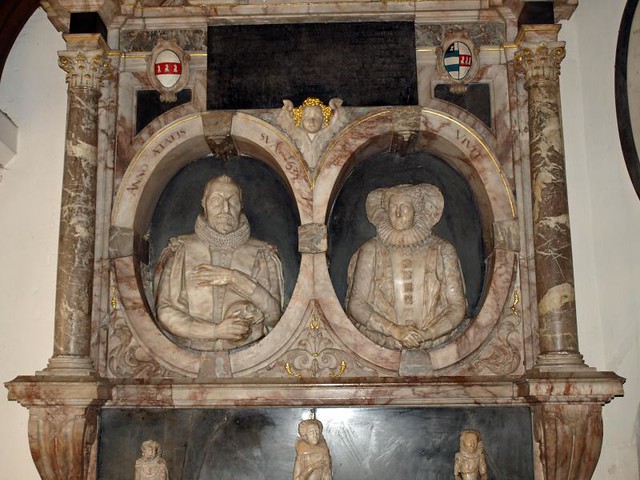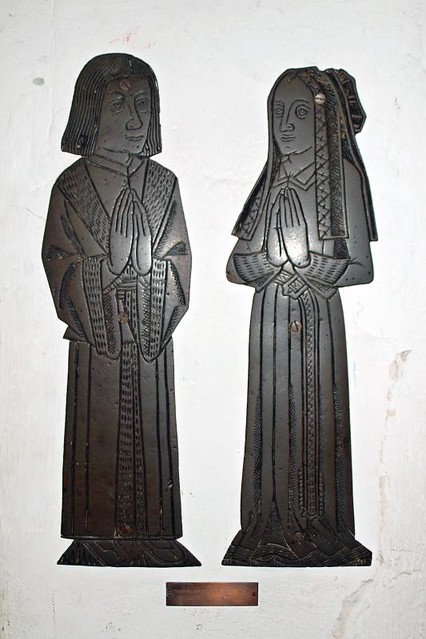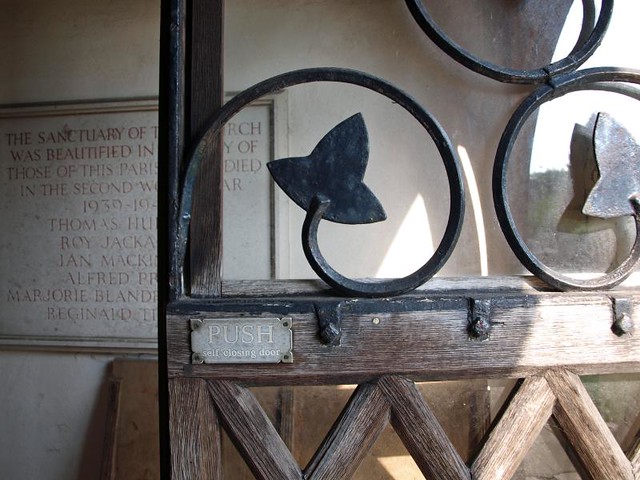ST MARY. Built probably in 1494, the date appearing in an inscription on the W tower. Flint and iron-stone with white stone dressings. W tower with diagonal buttresses, battlements and higher SW turret. C18 copper BEACON on top, a great rarity. Nave and aisles of two bays; the tower opens in a further bay into the aisles. In addition chancel aisles of one bay. Their arches have the simplest mouldings (concave double-chamfers). The nave piers have capitals only towards the arches, not towards the nave. The arches are four-centred. Squints from both chancel chapels to the chancel. - STAINED GLASS. E window by Warrington, 1846 (signed); S transept E window by Wailes; other contemporary glass. - PLATE. An unusually fine collection. Cup, 1562; Standing Cup and Cover, 1586; Flagon, 1609, of coffee-pot shape; Cup and Obelisk Cover, 1610; another, 1615, especially handsomely decorated; Paten, 1618. - MONUMENTS. Unusual number of small brasses: Lady, C15 (in front of the altar); two ladies (S transept E wall); man and woman, C16 (chancel S wall); woman in demi-profile, c. 1504 (S transept W wall); William Turnour d. 1500 and wife and children (S aisle). - In addition the following later monuments: Sir Roger Wilbraham d. 1616, by Nicholas Stone, epitaph with two busts of outstanding quality in oval niches, the attitudes of exquisite Mannerism. - Alice Stamford and her son, 1626, epitaph with painted portrait of the son, and painted decoration. - Elizabeth Davies d. 1678, epitaph without figures, signed by William Stanton. - Richmond Moore d. 1796, epitaph with female in mournful attitude by a broken column; unsigned.
Today Hadley Green is one of the prettiest pieces of Georgian development to be found near London. Among the 17th and 18th century houses that border it, are the Wilbraham Almshouses, red-brick cottages built in 1612, and a white house, now marked by a blue plaque, where the missionary and traveller David Livingstone stayed in 1857 and wrote his Missionary Travels and Researches in South Africa before returning there in 1858.
On the corner of the Green, screened by trees, is the parish church of St Mary the Virgin. A church existed in the 12th century, but the present building was erected in 1494 - the date is over the west door, a curious half-eight being used to represent a four -of flint and ironstone with white stone dressings. On top of the tower is a copper beacon or cresset, set up not as an Armada warning but during the 18th century, possibly to celebrate the recovery of George III from his illness, and last lit in rejoicing at the Coronation of Queen Elizabeth II (1953).
Inside are a nave, two aisles, a chancel, and two side chapels, dedicated to St Anne and St Catherine. Squints pierce the buttresses between the chancel and the chapels so that mass could be celebrated simultaneously at all three altars. On the capitals of the pillars is the crest of the Goodyere family - a partridge with an ear of wheat in its beak. It was John Goodyere, the lord of the manor, who, dying in 1504, left money “to the making of [the] first floure of the stepull in the said church of hadlegh as moch as it will cost the making of carpentry”. His memorial, a brass, has disappeared, but his wife can still be seen in her long robe and elaborate headdress.
Hadley Church contains one of the finest collections of small brasses to be seen in the county. There is William Turnour (d. 1500) with his wife and four children and, lacking their inscriptions so that they cannot be identified, are two 15th century ladies and a 16th century man and his wife. In addition to the brasses there is a fine monument by the sculptor Nicholas Stone to Sir Roger and Lady Wilbraham who endowed the almshouses on the Green. Sir Roger died in 1616, having been Solicitor General of Ireland. His monument, which cost £50, shows busts of himself and Lady Wilbraham while underneath kneel three pretty daughters with long hair. In the corner of the chancel is another monument to Henry Carew (d. 1620) and his mother, Lady Alice Stamford (d. 1573); his family became lords of the manor after the Abbot of Walden in Essex had been forced to surrender the ownership at the Reformation.
St Mary’s also possesses an exceptionally fine collection of 16th and early 17th century communion plate - a silver gilt flagon, patten and cups - so valuable and so large that a good part of it is on loan to the British Museum.
Beyond the church are 200 acres of Hadley Common which was originally a part of Enfield Chase, the King’s own hunting ground.
On the corner of the Green, screened by trees, is the parish church of St Mary the Virgin. A church existed in the 12th century, but the present building was erected in 1494 - the date is over the west door, a curious half-eight being used to represent a four -of flint and ironstone with white stone dressings. On top of the tower is a copper beacon or cresset, set up not as an Armada warning but during the 18th century, possibly to celebrate the recovery of George III from his illness, and last lit in rejoicing at the Coronation of Queen Elizabeth II (1953).
Inside are a nave, two aisles, a chancel, and two side chapels, dedicated to St Anne and St Catherine. Squints pierce the buttresses between the chancel and the chapels so that mass could be celebrated simultaneously at all three altars. On the capitals of the pillars is the crest of the Goodyere family - a partridge with an ear of wheat in its beak. It was John Goodyere, the lord of the manor, who, dying in 1504, left money “to the making of [the] first floure of the stepull in the said church of hadlegh as moch as it will cost the making of carpentry”. His memorial, a brass, has disappeared, but his wife can still be seen in her long robe and elaborate headdress.
Hadley Church contains one of the finest collections of small brasses to be seen in the county. There is William Turnour (d. 1500) with his wife and four children and, lacking their inscriptions so that they cannot be identified, are two 15th century ladies and a 16th century man and his wife. In addition to the brasses there is a fine monument by the sculptor Nicholas Stone to Sir Roger and Lady Wilbraham who endowed the almshouses on the Green. Sir Roger died in 1616, having been Solicitor General of Ireland. His monument, which cost £50, shows busts of himself and Lady Wilbraham while underneath kneel three pretty daughters with long hair. In the corner of the chancel is another monument to Henry Carew (d. 1620) and his mother, Lady Alice Stamford (d. 1573); his family became lords of the manor after the Abbot of Walden in Essex had been forced to surrender the ownership at the Reformation.
St Mary’s also possesses an exceptionally fine collection of 16th and early 17th century communion plate - a silver gilt flagon, patten and cups - so valuable and so large that a good part of it is on loan to the British Museum.
Beyond the church are 200 acres of Hadley Common which was originally a part of Enfield Chase, the King’s own hunting ground.



No comments:
Post a Comment